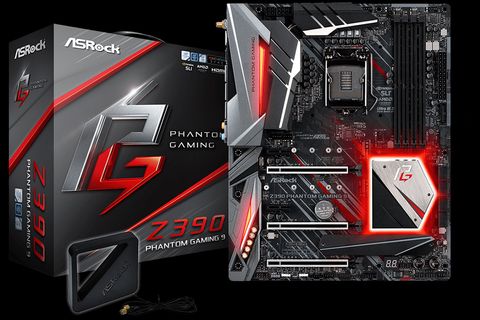Tom's Hardware Verdict
Buyers who need something faster than Gigabit Ethernet but can’t afford to implement 10GbE will find good value in the Z390 Phantom Gaming 9.
Pros
- +
Triple Ethernet Plus 1.73Gb/s Wi-Fi
- +
2.5GbE is cheaper to implement than 10GbE
- +
Features-per-price slightly better than 10GbE version
Cons
- -
Mediocre overclocking
- -
Mediocre voltage regulator cooling
Why you can trust Tom's Hardware
Features and Layout
It’s no secret that 10GbE can be expensive to install, but what if you want something faster than Gigabit Ethernet over a single cable? ASRock’s 2.5GbE-equipped Z390 Phantom Gaming 9 splits the price difference between its 10GbE and base models, supports cheaper Cat 5e cabling, and comes with all the other added features of the 10GbE model. Those “other added features”, such as faster Wi-Fi, tip value towards the cheaper Z390 Phantom Gaming 9.
Specifications
| Socket | LGA 1151 |
| Chipset | Intel Z390 |
| Form Factor | ATX |
| Voltage Regulator | 12 Phases |
| Video Ports | DisplayPort 1.2, HDMI 1.4 |
| USB Ports | 10 Gbps: (1) Type-C, (3) Type A 5Gb/s: (4) Type A |
| Network Jacks | (1) 2.5GbE, (2) Gigabit Ethernet, (2) Wi-Fi Antenna |
| Audio Jacks | (5) Analog, (1) Digital Out |
| Legacy Ports/Jacks | (1) PS/2 |
| Other Ports/Jack | CLR_CMOS Button |
| PCIe x16 | (3) v3.0 (x16/x0/x0, x8/x8/x0, x8/x4/x4) |
| PCIe x8 | ✗ |
| PCIe x4 | ✗ |
| PCIe x1 | (2) v3.0 |
| CrossFire/SLI | 3x / 2x |
| DIMM slots | (4) DDR4 |
| M.2 slots | (3) PCIe 3.0 x4^ / SATA* (*Consumes SATA Port 3, ^0/1, 4/5) |
| U.2 Ports | ✗ |
| SATA Ports | (8) 6Gb/s (Ports 0/1, 3, 4/5 shared w/M.2) |
| USB Headers | (1) 10Gb/s Type-C, (2) v3.0, (1.5) v2.0 |
| Fan Headers | (8) 4-Pin |
| Legacy Interfaces | ✗ |
| Other Interfaces | FP-Audio, D-LED, (2) RGB-LED, Thunderbolt AIC, TPM |
| Diagnostics Panel | Numeric |
| Internal Button/Switch | Power, Reset / ✗ |
| SATA Controllers | Integrated (0/1/5/10), ASM1061 PCIe |
| Ethernet Controllers | RTL8125AG PCIe, WGI211AT PCIe, WGI219V PHY |
| Wi-Fi / Bluetooth | Intel 9560 802.11ac 2x2 (1.73Gb/s) / BT 5 Combo |
| USB Controllers | ASM1074 Hub |
| HD Audio Codec | ALC1220 |
| DDL/DTS Connect | ✗ / ✗ |
| Warranty | 3 Years |
Those of you who have a good memory for images might be confused by the branding, since ASRock’s Z390 Phantom Gaming 9 uses the same plastic covers over its I/O panel and audio pathways as the Z390 Taichi Ultimate, to cover the same voltage regulator and sinks as that more-expensive board. It even uses the same PCB, leaving only the PCH sink and some screen printing to differentiate its “Taichi” and “Phantom Gaming” brands. The Phantom Gaming 9 is basically a Taichi Ultimate with a Realtek 2.5GbE controller in place of the more-expensive board’s Aquantia 10GbE controller. The Phantom Gaming 9 splits the price difference between the Taichi Ultimate and base-model Taichi, to which we say “fair enough”.
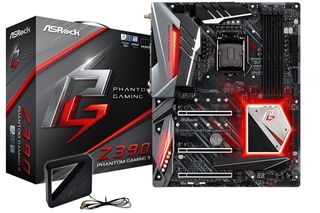
Buyers still get a third Gigabit Ethernet port that’s faster than the other two (Intel Gigabit Ethernet), and the Phantom Gaming 9 even has the 1.73Gb/s version of Intel’s latest M.2 Wi-Fi/BT 5.0 module, so its feature set is closer to that of the Taichi Ultimate than to the Taichi. The rest of the I/O panel connections remain the same too, with four 10Gb/s and four 5Gb/s USB 3.1 ports, a legacy PS/2 port, DisplayPort 1.2, HDMI 1.4, five analog audio jacks, and a digital audio output. We just think that if ASRock wants to build a brand, it could do more to visually differentiate those products.
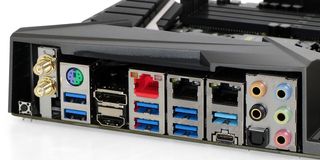
Like every other version of the board, the Z390 Phantom Gaming 9 splits its top x16 slot into x8/x8 and x8/x4/x4 modes as cards are added to the other silver slots, which still means that users of two PCIe NVMe drives will get the benefit of two sets of direct pathways to the CPU, while those hoping to enable SLI will need to leave the lower slot empty to make sure the middle slot gets the required eight lanes. All three boards also tie three M.2 slots to Z390 PCH pathways, forcing them to share the bandwidth of the four-lane DMI between the PCH and CPU. The metallic-colored power and reset buttons in the lower front corner are reserved for the Phantom Gaming 9 and Taichi Ultimate, however.
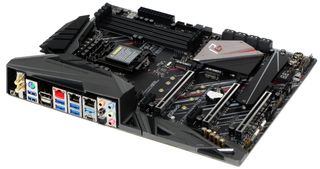
At the risk of sounding repetitive, the bottom of the Z390 Phantom Gaming 9 is filled with the types of cable headers for which cabled can generally be folded under the heat sink of a graphics card. These include a front panel HD Audio at the back, followed by Addressable LED, two regular RGB LED, Thunderbolt add-in card, one (of eight) four-pin fan, TPM, a four-pin (single-port) USB 2.0 half header, a standard nine-pin (2-port) USB 2.0, beep-code speaker and legacy (three-pin spaced) front-panel LED, an Intel-standard LED/button group, and another four-pin fan. Seven of the fan headers have both PWM and voltage-based control options, but the CPU fan header is PWM-only.
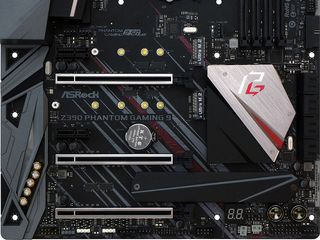
Two of the PCH-connected M.2 slots support 110mm-long drives, but the top one is limited to an 80mm maximum so that a PCIe x1 slot will also fit, While both PCIe x1 slots are open-ended, placing a long card (such as x4) in the top one requires shoving it down against the top of any M.2 drive mounted there, and the second one appears to fit nothing longer than an x4-slot card due to RTC battery placement. Our only concerns here are interface length, since the front-panel USB 3.1 Gen2 header is positioned between the forward edges of any cards mounted in the top x1 and top x16 slots, and the SATA interfaces forward of the lower slots point forward, under the cards.

Other than the limits mentioned above on installing longer-than-x1 cards in the open-ended x1 slots, the Z390 Phantom Gaming 9 doesn’t have any noticeable layout issues. HSIO sharing between SATA and M.2 ports is still an issue brought on by the Z390’s paucity of resources, but the fact that filling the M.2 slots can cause half the SATA ports to be shut off (see our features chart) has little do to with layout. Users with extra-old cases might find that the forward-facing SATA and front-panel USB 3.0 ports are pointing directly into a drive cage, but that’s broadly been addressed in enthusiast-market cases for at least the past decade. The second front-panel USB 3.0 header points outward, just like the Gen2 USB 3.1 header, and both are well out of the conflict area of expansion cards.
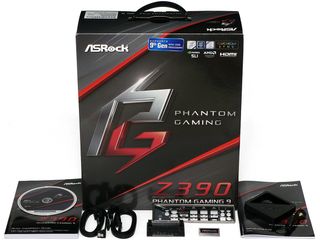
The Z390 Phantom Gaming 9 includes a driver disc and documentation, four SATA cables, an I/O shield, a high-bandwidth SLI bridge, a case badge, and a Wi-Fi antenna.
MORE: Best Motherboards
MORE: How To Choose A Motherboard
MORE: All Motherboard Content

Chinese researchers use low-cost Nvidia chip for hypersonic weapon —unrestricted Nvidia Jetson TX2i powers guidance system

ChatGPT can craft attacks based on chip vulnerabilities — GPT-4 model tested by UIUC computer scientists

ASRock reveals two new 27-inch 1440p IPS monitors, one with an integrated Wi-Fi antenna in the stand
-
derekullo Do you need to buy a special 2.5 gigabit router/switch for this to work?Reply
Even something as crazy looking as the ROG Rapture GT-AC5300 makes no mention of it supporting 2.5 gigabit wired. -
Crashman Reply
5GbE switches should all be wired for it, but I don't know which 10GbE switches will support it.21642712 said:Do you need to buy a special 2.5 gigabit router/switch for this to work?
Even something as crazy looking as the ROG Rapture GT-AC5300 makes no mention of it supporting 2.5 gigabit wired.
-
hassanergene You need a switch that supports it yes, 2.5G and 5G are part of the N-Base-T standard. Some 10G switches will also support these speeds, now or in the near future.Reply -
whazzup Was there a section on the performance of the 2.5GbE that I missed? Or is the network speed not tested in this article?Reply -
hassanergene I did not see benchmarks on ethernet either; however, by the nature of how copper ethernet works a PHY is a PHY, it will always transmit at line rate (e.g. 2.5Gbps always). The only way to tune it is to change packet size, e.g. enable jumbo frames you will get more data through since there is less preamble/packet info transmitted, more raw data. These PHY's need to interoperate so they follow a strict standard and data rate with one acting as a master and the other as a slave to stay in sync. So there isn't too much point in benchmarking network cards. The thing about these cards though is since their data rates are higher there is less latency on the MAC layer since they have to operate faster in order to support the faster line rates. In a way it is overclocking the PHY to MAC layer with faster ethernet standards.Reply -
USAFRet Reply
Please start a new thread for your question.OCtransplant said:Can someone please tell me if the Gigabyte AORUS NVMe SSD is compatible with this motherboard? It looks like the bottom-right M.2 slot has a built-in heatsink, but I wouldn't mind removing it if I need to. Or could I use a different slot for my primary M.2 SSD? Below is a link to the Newegg page of the SSD to which I am referring. Any help is appreciated!
https://www.newegg.com/gigabyte-aorus-1tb/p/N82E16820009012
This one is a year old, and has nothing to do with drives and motherboards.
